Mold growth is a common problem in many homes. Bathrooms, basements, laundry rooms, and garages are where you’ll typically encounter home mold problems.
At least half of the houses in America are believed to contain some amount of mold. Some estimates even put it as high as 70% of houses being affected.
Household environments that are damp, dark, humid, and poorly ventilated are breeding grounds for mold.
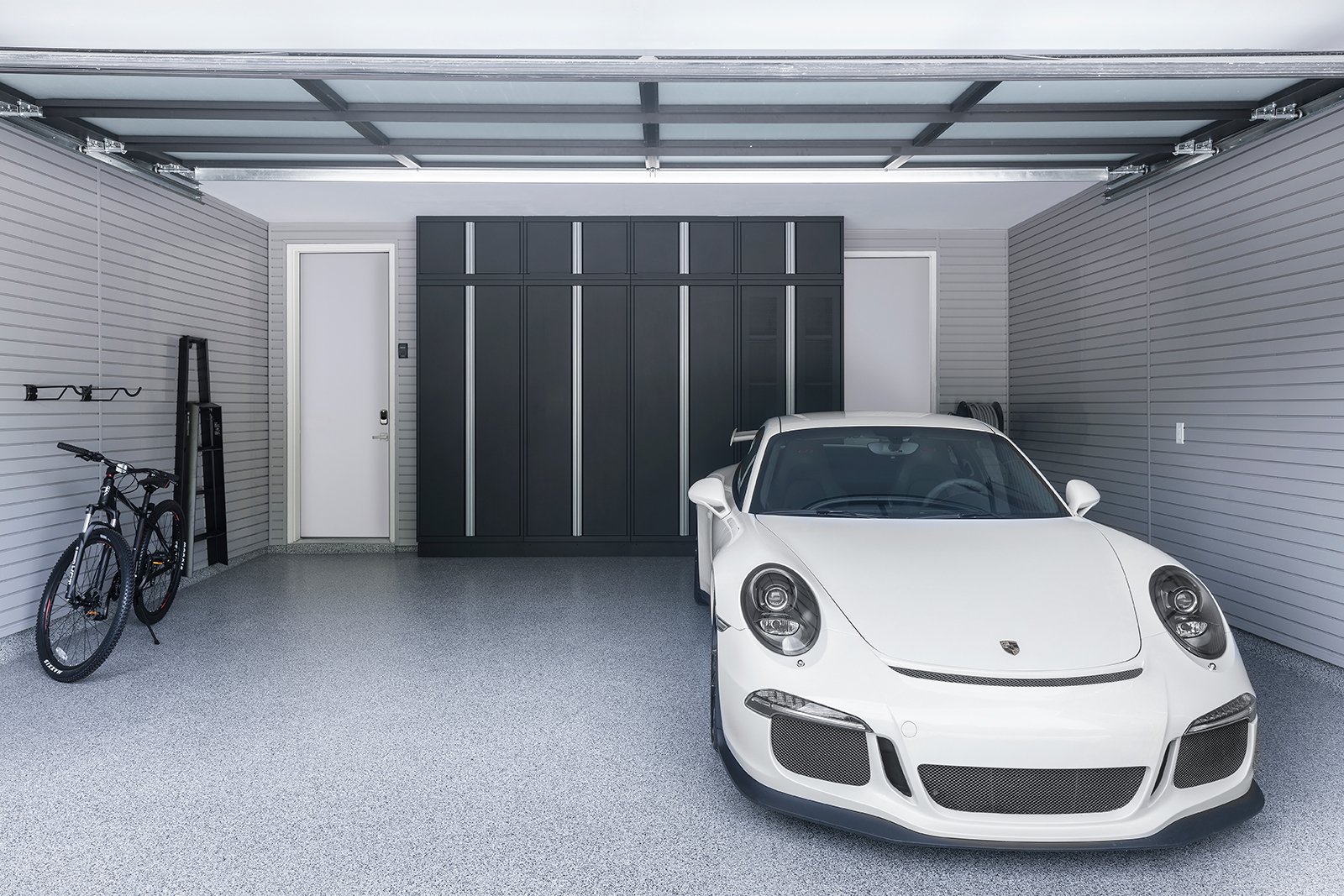
Having mold in the garage and elsewhere in the home can:
- pose a health risk
- harm the structural integrity of your house
- lead to costly repairs
- damage your belongings
In this blog post, we’ll focus on mold in the garage and explain the health risks, how to identify it, what causes it, and how to prevent and remove garage mold.
Is mold in the garage dangerous?
Mold is a fungal growth that produces microscopic spores that are all around us. There are more than 100,000 different mold species.
Common household molds are classified as allergenic, pathogenic, and toxigenic. The latter type, which includes “black mold”, poses the biggest health risk.
Airborne mold spores can be an irritant to people with asthma and certain allergies. The spores become more problematic when they find a suitable environment to grow, such as in a garage.
Some people aren’t affected at all by most types of household molds. Other people with certain health conditions like asthma, allergies, emphysema, and bronchitis are more likely to be affected if their garage has mold.
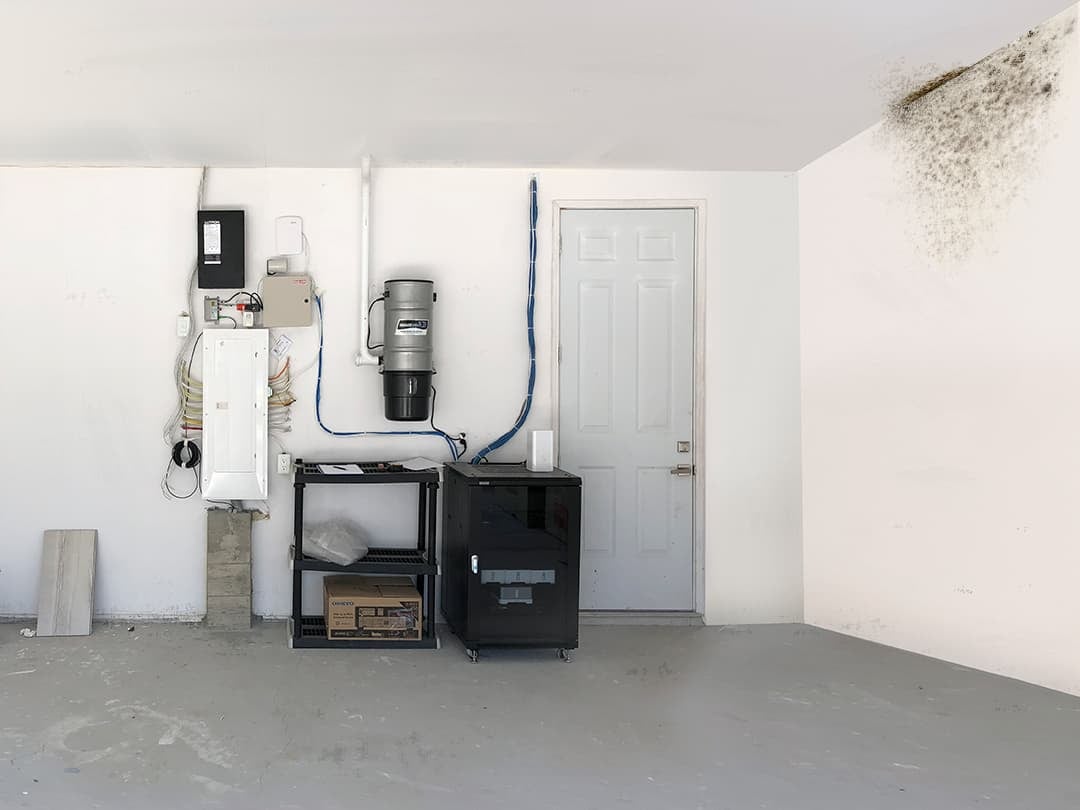
Garages are one of several areas in our homes that can be susceptible to mold growth.
Studies have also shown that infants and children who live in environments with high mold levels are more at risk to develop asthma. So yes, mold in the garage can be dangerous for some people.
We use our garages for so many things, including parking our vehicles, storage, and as a hobby space. Garages have replaced the front door as the main home entry and exit point for many of us.
Because our garages are used so frequently, it’s essential to keep them clean, safe, and mold-free.
How to identify mold in the garage
Mold primarily feeds on organic materials and can lurk anywhere in a garage, such as on the floor, walls, ceiling, and loose objects. There are a few ways to tell if your garage has a mold problem:
- You’ll notice a damp, musty odor.
- You can detect signs of mold growth on surfaces. Mold can also grow behind walls and ceilings.
- You’ll experience a bodily reaction to the presence of mold (including an allergic reaction, coughing, skin irritation, itchy red eyes, and asthmatic symptoms).
Household mold is black, white, green, grey, or orange with a fuzzy or slimy texture and stain-like appearance.
Mold and mildew are often confused with one another. Both are fungal growths. Mildew is typically grey, yellow, or white and has a powdery texture. Mildew grows on the surface of objects, so it’s easier to deal with than mold which can penetrate the surfaces of things it grows on.
What causes mold in the garage?
Most garages have ideal conditions for mold to thrive, especially unfinished garages. They tend to lack much natural light and effective ventilation and are prone to high humidity and condensation levels.
Mold spores are spread by the wind, insects, animals, water, yard tools, and many other methods. The higher temperature and precipitation levels between early spring and fall make this the prime period during the year for mold growth.
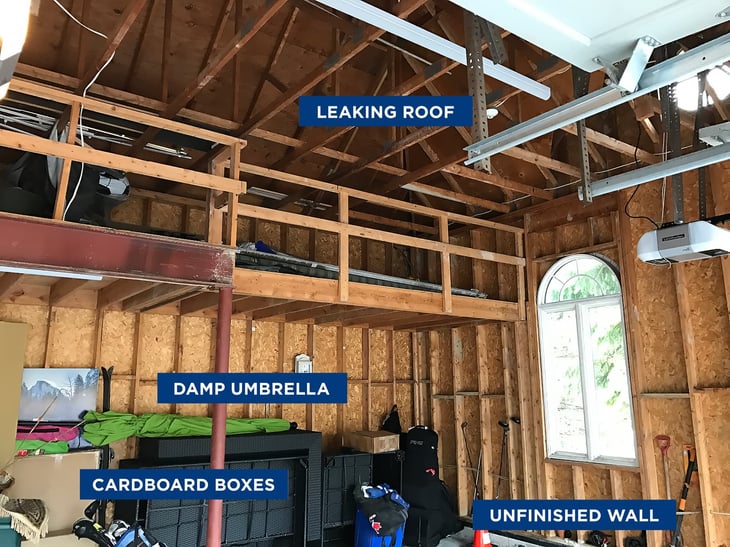
Unfinished garages with clutter and a leaky roof create an ideal environment for mold to grow.
Once mold spores settle on a wet surface, it takes 24-48 hours for mold to start growing. Mold loves to grow on organic matter like cardboard, wood, and fabric.
The New York Times reports, “Mold spores stick to surfaces and, if conditions are sufficiently warm, moist, and undisturbed, extrude tendrils which turn almost any surface into food. Ceiling tiles, wood, paint, rubber, carpet, soil, dust; it’s all food to the mold, just add water.”
The environmental conditions of garages aren’t the only reason mold is attracted to them. Garages are more susceptible to mold because the average garage door is opened 3-5 times every day, which gives mold spores plenty of opportunities to come indoors. Garages are also a home access hub, so mold spores can be transported inside on clothing, shoes, and shopping bags.
Additional things that can cause garage mold
Other factors can make the garage a more hospitable environment for mold. Here are some examples:
- water damage from a burst pipe or flooding that wasn’t properly dealt with
- a leaky roof
- garage doors that are left open too long when it’s raining or snowing (especially when it's windy)
- no floor drainage or the drainage system is blocked
- too much rain, ice, and snow from vehicles is being left on the floor
- poorly sealed garage doors
- the ventilation system isn’t working properly
- the garage isn’t being fully dried out after washing a car or the floor
- running an old fridge is increasing the condensation levels in the garage
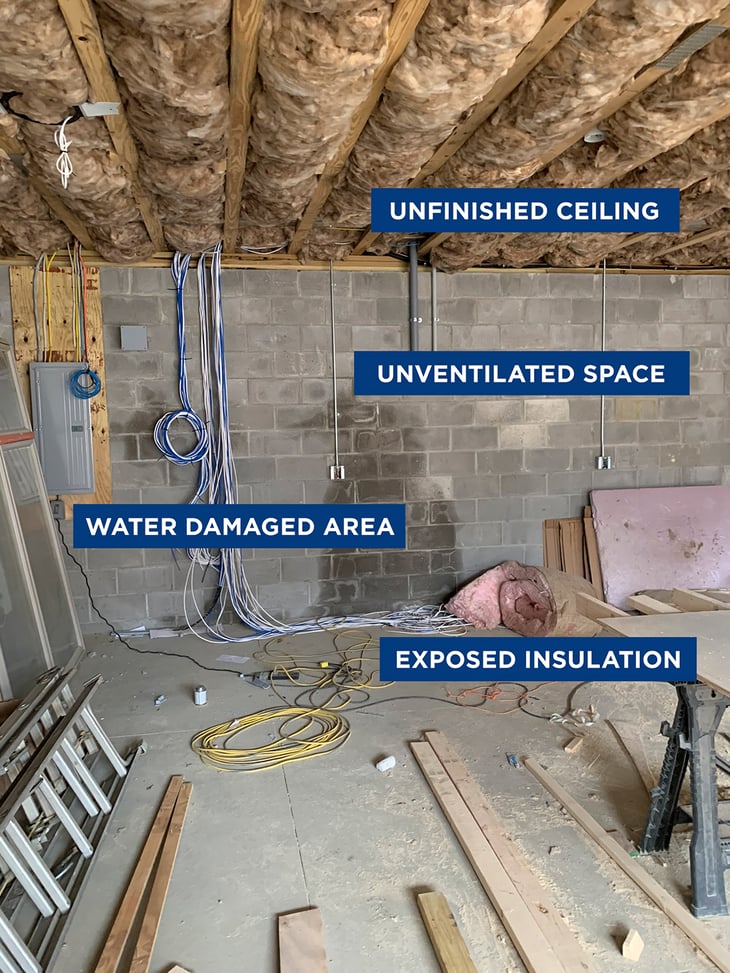
Susceptible mold areas: an unfinished ceiling, water damage on the cinder block wall, and exposed insulation.
7 ways to prevent garage mold
There are plenty of preventative measures you can take to prevent mold in the garage from becoming an issue. Here are several ways to safeguard your garage from mold:
- Use mold-resistant building materials: wood studs attract mold, so use metal studs if you’re building or remodeling a garage. Don’t leave drywall unpainted and use a mold and mildew-resistant paint. Consider getting a Floortex™ floor coating, which provides a 100% water-resistant floor seal and visual appeal.
- Control the humidity level: use a dehumidifier to effectively manage a garage’s humidity level. A humidity level somewhere between 35-60% should suffice for most garages.
- Deal with excess water promptly: clean up thoroughly after a flood or after roof or plumbing leaks are detected and fixed. Use a squeegee, sponge, or mop to remove standing water on the floor from melted snow and after using a hose in the garage.
- Install a garage ventilation system: improve the airflow in the garage by ensuring it has sufficient ventilation.
- Eliminate junk and clutter: remove unnecessary items from the garage like cardboard boxes and old furniture. Floor clutter makes any garage less functional and gives mold more surfaces to grow on and hide behind. Keep your garage organized by using cabinet, overhead, and wall storage systems.
- Have adequate floor drainage: a properly sloped garage floor and efficient drainage system will take care of most excess water on a floor.
- Increase the amount of natural light: garages that get more natural light are a less ideal environment for mold growth. Larger windows, garage doors with window panels, and an exterior access door with a window can all bring more natural light into a garage. Try to use opaque glass for privacy and security reasons.
How to get rid of mold in the garage
Mold spreads as it grows, so dealing with it right away after becoming aware of it is essential.
Removing small areas of mold in the garage can be done yourself. The Environmental Protection Agency recommends that you hire a certified mold removal professional if the affected area is more than 10 square feet.
To get rid of garage mold yourself, first make sure the room is well-ventilated. Wear gloves, goggles, and a respirator or good face mask during the cleanup process to avoid exposure to mold spores.
Containing the spores while cleaning is important so they don’t spread to other areas of the garage. Never “dry scrub” a moldy area. Spray it first with a commercial mold removal cleaner, warm water, or a water/bleach mixture.
A mold removal product will produce the best cleaning results. The right mixture of water and certain household items like detergent, distilled white vinegar, and bleach can also be effective. Be aware that some of these cleaning liquids and the mold itself may cause staining and cosmetic damage on some surfaces.
After letting the cleaner you’re using sit on the mold for a short period, scrub the area with a brush that has stiff bristles. Inspect the area after rinsing it with water and repeat the process until all the mold is gone. Dry the mold-affected area and surrounding area thoroughly. Monitor the cleaned-up area for a few weeks to ensure no mold grows back.
If your mold problem is more serious or if you’re unsure or uncomfortable removing mold in the garage yourself, seek professional mold removal help.
Update and transform your garage space
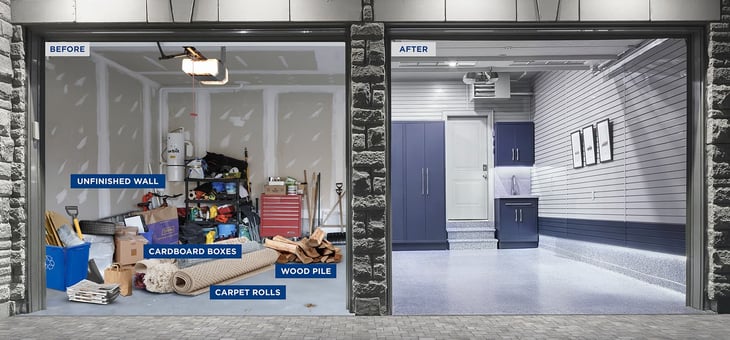
Don’t let mold take over your garage. Take proactive steps to ensure your home has a mold-free garage space for your well-being and your belongings.
One reason mold can become a problem in garages is that the space tends to get neglected. Unfinished garages have an outdated look and limited functionality, so their owners are less inspired to keep them looking good and use them in their leisure time.
Giving your unfinished garage a remodel will turn it into a clean, organized, stylish-looking space that can be easier to keep free of mold.
Schedule a free design consultation with Garage Living to begin the process of transforming and updating your garage space.
Please share this article if you found it useful.